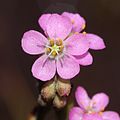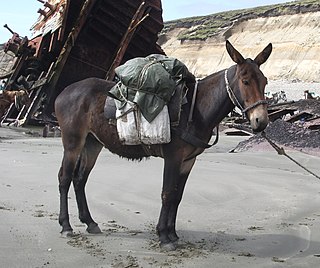
In biology, a hybrid is the offspring resulting from combining the qualities of two organisms of different varieties, species or genera through sexual reproduction. Generally, it means that each cell has genetic material from two different organisms, whereas an individual where some cells are derived from a different organism is called a chimera. Hybrids are not always intermediates between their parents, but can show hybrid vigor, sometimes growing larger or taller than either parent. The concept of a hybrid is interpreted differently in animal and plant breeding, where there is interest in the individual parentage. In genetics, attention is focused on the numbers of chromosomes. In taxonomy, a key question is how closely related the parent species are.

Drosera, which is commonly known as the sundews, is one of the largest genera of carnivorous plants, with at least 194 species. These members of the family Droseraceae lure, capture, and digest insects using stalked mucilaginous glands covering their leaf surfaces. The insects are used to supplement the poor mineral nutrition of the soil in which the plants grow. Various species, which vary greatly in size and form, are native to every continent except Antarctica.

Dendrobium is a genus of mostly epiphytic and lithophytic orchids in the family Orchidaceae. It is a very large genus, containing more than 1,800 species that are found in diverse habitats throughout much of south, east and southeast Asia, including China, Japan, India, the Philippines, Indonesia, Australia, New Guinea, Vietnam and many of the islands of the Pacific. Orchids in this genus have roots that creep over the surface of trees or rocks, rarely having their roots in soil. Up to six leaves develop in a tuft at the tip of a shoot and from one to a large number of flowers are arranged along an unbranched flowering stem. Several attempts have been made to separate Dendrobium into smaller genera, but most have not been accepted by the World Checklist of Selected Plant Families.

Drosera spatulata, the spoon-leaved sundew, is a variable, rosette-forming sundew with spoon-shaped leaves. The specific epithet is Latin for "spatula shaped," a reference to the form of the leaves. This sundew has a large range and occurs naturally throughout Southeast Asia, southern China and Japan, Micronesia, Papua New Guinea, eastern Australia, Tasmania and New Zealand. Variants are often known by the localities in which they are found. The plant does not form hibernacula in winter, and is easily grown using the same methods as Drosera capensis.

Drosera regia, commonly known as the king sundew, is a carnivorous plant in the sundew genus Drosera that is endemic to a single valley in South Africa. The genus name Drosera comes from the Greek word droseros, meaning "dew-covered". The specific epithet regia is derived from the Latin for "royal", a reference to the "striking appearance" of the species. Individual leaves can reach 70 cm (28 in) in length. It has many unusual relict characteristics not found in most other Drosera species, including woody rhizomes, operculate pollen, and the lack of circinate vernation in scape growth. All of these factors, combined with molecular data from phylogenetic analysis, contribute to the evidence that D. regia possesses some of the most ancient characteristics within the genus. Some of these are shared with the related Venus flytrap (Dionaea muscipula), which suggests a close evolutionary relationship.

Drosera adelae, commonly known as the lance-leaved sundew, is a carnivorous plant in the genus Drosera that is endemic to Queensland, Australia.

The Carnivorous Plant Newsletter is the official publication of the International Carnivorous Plant Society (ICPS), the largest such organization in the world. It is headquartered in Walnut Creek, California.
The genus Drosera was divided in 1994 by Seine & Barthlott into three subgenera and 11 sections on the basis of morphological characteristics.
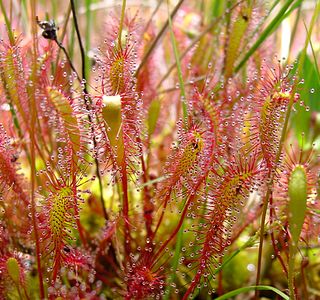
Drosera anglica, commonly known as the English sundew or great sundew, is a carnivorous flowering plant species belonging to the sundew family Droseraceae. It is a temperate species with a circumboreal range, although it does occur as far south as Japan, southern Europe, and the island of Kauai in Hawaii, where it grows as a tropical sundew. It is thought to originate from an amphidiploid hybrid of D. rotundifolia and D. linearis, meaning that a sterile hybrid between these two species doubled its chromosomes to produce fertile progeny which stabilized into the current D. anglica.
The mechanisms of reproductive isolation are a collection of evolutionary mechanisms, behaviors and physiological processes critical for speciation. They prevent members of different species from producing offspring, or ensure that any offspring are sterile. These barriers maintain the integrity of a species by reducing gene flow between related species.

Drosera indica is an insectivorous plant, a sundew native to tropical countries throughout the world, from Asia to Africa, but absent from the neotropics. Together with Australian endemic species D. aquatica, D. aurantiaca, D. barrettorum, D. cucullata, D. finlaysoniana, D. fragrans, D. glabriscapa, D. hartmeyerorum, D. nana, D. serpens it makes up the section Arachnopus.

Drosera filiformis, commonly known as the thread-leaved sundew, is a small, insectivorous, rosette-forming species of perennial herb. A species of sundew, it is unusual within its genus in that the long, erect, filiform (thread-like) leaves of this plant unroll in spirals – an arrangement similar to the circinate vernation seen in ferns.
There are fourteen species of carnivorous plants occurring in New Zealand, and four species that have been known to occur in the past.
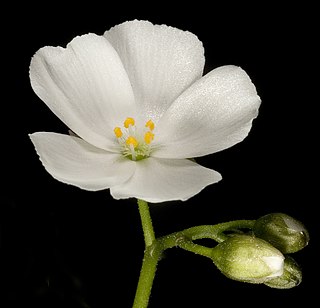
Drosera porrecta is a tuberous perennial species in the genus Drosera that is endemic to Western Australia. It grows up to 45 cm tall. It is native to a region from Eneabba and Marchagee south to an area around Pinjarra, including the Darling Range and Mount Cooke. It grows in well-drained sandy soils and flowers from July to September.

Drosera sessilifolia is a species in the carnivorous plant genus Drosera that is native to Brazil, Guyana, and Venezuela and grows in sandy or gravelly soils in seasonal seepages where a thin film of water collects. It produces a rosette of small, wedge-shaped to round carnivorous leaves that are usually yellowish but become redder with age. Inflorescences produce pink-lilac flowers. It has a diploid chromosome number of 2n = 20.
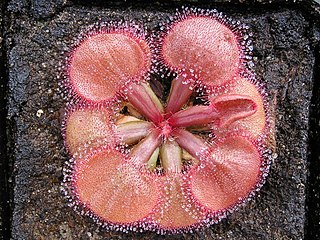
Drosera falconeri is a carnivorous plant in the family of Droseraceae. It is endemic to the Northern Territory of Australia.

Drosera ultramafica is a species of sundew native to the highlands of Malesia. It is thought to be most closely related to Drosera spatulata, Drosera neocaledonica and Drosera oblanceolata. The taxon is readily distinguished from the former by its general habit and preference for mafic, upland habitats, and from the latter species by specific morphological differences, in addition to the fact that their geographical ranges do not overlap.
Drosera viridis is a semi-erect or rosetted perennial species in the carnivorous plant genus Drosera. It is known only from Brazil, being found in eastern Paraná and São Paulo and central Santa Catarina at elevations from 550–1,100 m (1,800–3,610 ft). It may, however, also be found in adjacent Argentina, Paraguay, and Uruguay. It typically grows in waterlogged habitats among grasses in white-clayey, reddish lateritic, or humus-rich black-brown soils and is sometimes found submerged with only the leaves above water.
Drosera peruensis is a carnivorous plant of the genus Drosera, commonly known as the Peruvian sundew. This Drosera species was first identified in Peru in 2002 by Tânia Regina dos Santos Silva and Mireya D. Correa following work to update the genus Drosera for the reference text, Flora Neotropica..

Gustaf Otto Rosenberg, termed Otto Rosenberg in publications, born June 9, 1872, in Gothenburg, Sweden, died November 30, 1948, was a Swedish botanist; son of Johan Olof Rosenberg.


